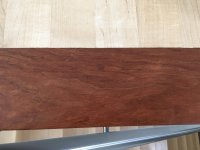Moments ago I was approaching the end of an entire day of plunging holes for hinges, shelf pins and drawer slides using my LR32 in a total of eight frameless birch cabinets - a mix of shallow base cabinets (with a single drawer and two doors beneath) and double and single door upper cabinets. This was the last step before moving over to the domino, having already cut all the panels to size, edge banded the panels with solid maple edge banding (using a router bit set), flush trimmed everything, routed the grooves for back panels, etc.
Let's just say that while beginning the layout for the center and back holes for the 9" Tandem slides, I stumbled on the fact that the stops on the LR32 end stops had, at some point earlier in the process, moved.
Neither one was any longer set to 37mm and what each had moved to was different (one was set at ~39mm, for instance, while the other was something different).
I am gutted.
In essence, most if not all of the side panels for these cabinets are now ruined. All because I failed to double check that the knobs on the ends stops were sufficiently tightened down. When I did check (after I identified the problem) I found that each had backed off slightly from fully tight (we've had wide temperature and humidity swings over the last week which may have contributed to this loosening) - enough to allow the stops to move.
Another factor is that most of the upper cabinets feature balanced side panels (800mm tall) and the force I was using to ensure that the pins on the stops were kissing the front of the panels, force required to nudge the guide rail (thanks to needing to overcome the snuggly sandwiched end stops and the sticky foam under the guide rail), was apparently enough to knock the stops off their settings.
Awesome end to the week.
So, now I'm contemplating sourcing some 5mm birch dowel stock to plug all the holes. But I think that's just a desperate hail mary given that these cabinets, like the others I've already fabricated and installed, were destined for a clear finish.
These are kitchen cabinets for a rental unit that I own and operate. So, I'm not sure how terrible a bunch of plugged holes would look when all is said and done. I'm just trying to justify not having to spend a(nother) small fortune buying more plywood to remake all the side panels. I've got plenty of maple to mill more edgebanding out of so the plywood (and all the wasted effort to date) is all I'd be overcoming. Of course, really, this is about my ego, my being embarrassed but also my wanting to present a professional product to future tenants. So, maybe I'm being too vain. Or maybe, by sharing this mistake here, I just need to vent my disappointment.
Anyways, the moral of the story is this: always, always, always ensure that the end stops are set as intended and regularly crank down on the knobs to ensure that nothing comes loose. Live and learn.
Let's just say that while beginning the layout for the center and back holes for the 9" Tandem slides, I stumbled on the fact that the stops on the LR32 end stops had, at some point earlier in the process, moved.
Neither one was any longer set to 37mm and what each had moved to was different (one was set at ~39mm, for instance, while the other was something different).
I am gutted.
In essence, most if not all of the side panels for these cabinets are now ruined. All because I failed to double check that the knobs on the ends stops were sufficiently tightened down. When I did check (after I identified the problem) I found that each had backed off slightly from fully tight (we've had wide temperature and humidity swings over the last week which may have contributed to this loosening) - enough to allow the stops to move.
Another factor is that most of the upper cabinets feature balanced side panels (800mm tall) and the force I was using to ensure that the pins on the stops were kissing the front of the panels, force required to nudge the guide rail (thanks to needing to overcome the snuggly sandwiched end stops and the sticky foam under the guide rail), was apparently enough to knock the stops off their settings.
Awesome end to the week.
So, now I'm contemplating sourcing some 5mm birch dowel stock to plug all the holes. But I think that's just a desperate hail mary given that these cabinets, like the others I've already fabricated and installed, were destined for a clear finish.
These are kitchen cabinets for a rental unit that I own and operate. So, I'm not sure how terrible a bunch of plugged holes would look when all is said and done. I'm just trying to justify not having to spend a(nother) small fortune buying more plywood to remake all the side panels. I've got plenty of maple to mill more edgebanding out of so the plywood (and all the wasted effort to date) is all I'd be overcoming. Of course, really, this is about my ego, my being embarrassed but also my wanting to present a professional product to future tenants. So, maybe I'm being too vain. Or maybe, by sharing this mistake here, I just need to vent my disappointment.
Anyways, the moral of the story is this: always, always, always ensure that the end stops are set as intended and regularly crank down on the knobs to ensure that nothing comes loose. Live and learn.

